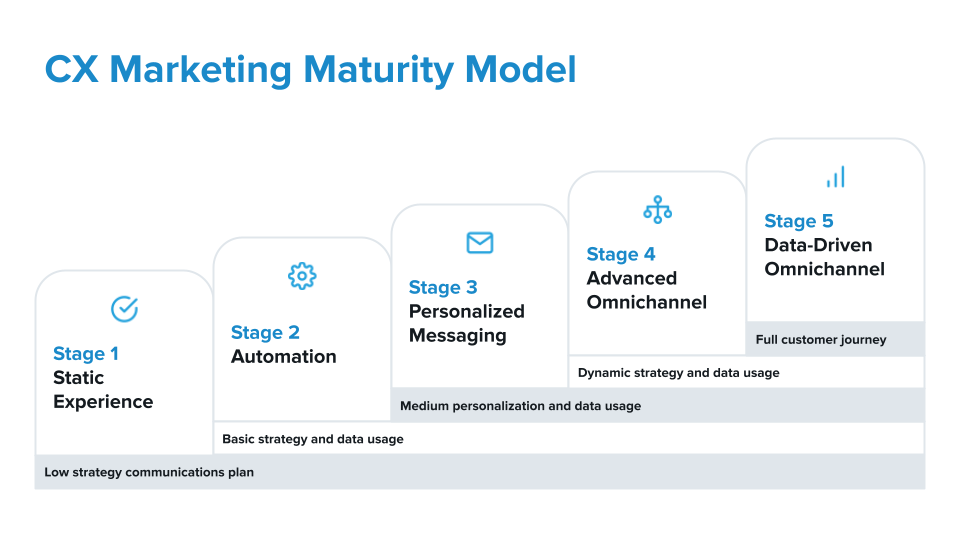
How to Use a Customer Experience Maturity Model

In today’s hyper-competitive business landscape, delivering an exceptional customer experience (CX) every time is not an option — it’s a necessity. But macro factors like the pandemic and fears of a looming economic downturn have created unprecedented challenges for marketers. Gone are the days of crafting an annual strategic plan and making minor adjustments along the way; starting over is the new normal, with a recent Acquia CX Trends report finding that over the past 18 months, 94% of marketers say their organization changed its digital CX strategy.
Businesses thriving during this tumultuous time are those that prioritize customer experiences and have committed to creating and growing their company’s CX programs. But if your business is starting from scratch, armed with nothing more than an email list and a desire to do better, what is the next step? And for companies that want to build on early personalization successes, how do you continue your CX journey?
That’s where a customer experience maturity model can help. With a CX maturity model in place, you’ll better understand how your organization is currently performing, identify areas for improvement, and prove the ROI of your CX efforts. Let’s take a closer look at the five stages of customer experience maturity and discuss the many benefits of making a CX maturity model a priority at your organization.
What is a CX maturity model?
A customer experience (CX) maturity model is a five-stage framework that helps your organization evaluate its current level of CX savvy and provides a roadmap for CX growth and improvement. It gives your company a framework for moving from a static, low-strategy communications cadence to a dynamic, data-driven approach that encompasses the entire customer journey.

The stages of the CX maturity model
Companies experience multiple stages on their journey to CX maturity, starting with a low-strategy static experience and culminating with a dynamic data-driven omnichannel effort.
1. Static experience
If your company is at stage 1 of CX maturity, you deliver a completely static experience. Businesses at this stage use a source of in-house data — like a contact list or CRM — to deliver messages via a single channel (like email) without practicing segmentation or targeting.
2. Automation
The next stage of CX maturity introduces automation. Companies at stage 2 use one-to-one data points to begin basic segmentation efforts and may introduce an additional data source like a web tag in an attempt to further refine their efforts. However, all channels remain siloed and separate, and marketers aren’t performing any personalization.
3. Personalized messaging
Companies at stage 3 of the CX maturity model embrace personalization, regularly using personalized content throughout campaigns. Businesses at stage 3 typically focus their efforts on one or two specific channels and simultaneously employ multiple scheduled and triggered segments based on both buyer’s stage in the buying cycle and their particular level and type of engagement.
4. Advanced omnichannel
Businesses at stage 4 of the CX maturity regularly use multiple channels — including web, mobile, email, and in-store — to connect with and engage customers. If your business is at this stage, all your data sources are unified into a customer data platform (CDP) that provides a 360° view of the customer, allowing you to perform dynamic segmentation based on one-to-many roll-ups and calculations.
5. Data-driven omnichannel
Organizations at the highest level of CX maturity harness the full power of technology — including machine learning — to provide data-driven insights and predictions that allow for advanced targeting and personalization. Marketers can perform dynamic segmentation based on key performance indicators (KPIs) and customer engagement, as well as customize reports to inform future strategies and performance.
Benefits of using a CX maturity model
Implementing a CX maturity model at your organization brings with it numerous benefits. It can:
- Identify your starting point: A customer experience maturity model gives your business a clear understanding of the current state of its customer experience capabilities. It also provides you with benchmarks for evaluating your company against best practices and industry standards.
- Highlight gaps and opportunities: Using a CX maturity model can help pinpoint gaps and missed opportunities in your organization’s CX strategies and practices.
- Provide a blueprint: Using a customer experience maturity model gives you a roadmap for growth, ensuring everyone in the organization is on the same page and helping determine best next steps for improving the customer experience.
- Track progress: With a CX maturity model in place, you can more easily and effectively measure progress toward your CX goals, identifying areas of success as well as those that need improvement. You’ll also be able to prove the ROI of your CX initiatives, helping justify future investments in CX improvements.
- Enhance the customer experience: Adopting and embracing a CX maturity model is a sign that your entire business is committed to putting the customer first — which not only delights customers but can boost customer loyalty and your bottom line.
Getting started
Growing your CX programs can be challenging, but adopting a five-stage CX maturity model can help streamline the journey from static, single-channel, low-strategy engagement to dynamic, data-driven omnichannel engagement. And embracing a CX maturity model can help you find out what’s working, what isn’t, and where there’s room for improvement, in addition to helping you make a case for future CX investments.
For many companies, investing in a CDP is a natural step along the path toward achieving CX maturity. Because it provides you with a centralized, 360° view of the customer, your CDP empowers you to glean insights and make data-driven decisions that were previously impossible. Learn more about how Acquia CDP can help take your CX program to the next level.
